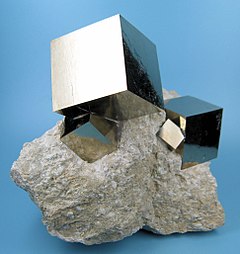Iron pyrite
| Pyrite | |
|---|---|

|
|
| General | |
| Category | Sulfide mineral |
|
Formula (repeating unit) |
FeS2 |
| Strunz classification | 2.EB.05a |
| Dana classification | 2.12.1.1 |
| Crystal system | Isometric |
| Crystal class | Diploidal (m3) H-M symbol: (2/m 3) |
| Space group | Pa3 |
| Unit cell | a = 5.417 Å, Z = 4 |
| Identification | |
| Formula mass | 119.98 g/mol |
| Color | Pale brass-yellow reflective; tarnishes darker and iridescent |
| Crystal habit | Cubic, faces may be striated, but also frequently octahedral and pyritohedron. Often inter-grown, massive, radiated, granular, globular, and stalactitic. |
| Twinning | Penetration and contact twinning |
| Cleavage | Indistinct on {001}; partings on {011} and {111} |
| Fracture | Very uneven, sometimes conchoidal |
| Tenacity | Brittle |
| Mohs scale hardness | 6–6.5 |
| Luster | Metallic, glistening |
| Streak | Greenish-black to brownish-black |
| Diaphaneity | Opaque |
| Specific gravity | 4.95–5.10 |
| Density | 4.8–5 g/cm3 |
| Fusibility | 2.5–3 to a magnetic globule |
| Solubility | Insoluble in water |
| Other characteristics | paramagnetic |
| References | |
The mineral pyrite, or iron pyrite, also known as fool's gold, is an iron sulfide with the chemical formula FeS2. This mineral's metallic luster and pale brass-yellow hue give it a superficial resemblance to gold, hence the well-known nickname of fool's gold. The color has also led to the nicknames brass, brazzle, and Brazil, primarily used to refer to pyrite found in coal.
Pyrite is the most common of the sulfide minerals. The name pyrite is derived from the Greek πυρίτης (pyritēs), "of fire" or "in fire", in turn from πύρ (pyr), "fire". In ancient Roman times, this name was applied to several types of stone that would create sparks when struck against steel; Pliny the Elder described one of them as being brassy, almost certainly a reference to what we now call pyrite. By Georgius Agricola's time, c. 1550, the term had become a generic term for all of the sulfide minerals.
Pyrite is usually found associated with other sulfides or oxides in quartz veins, sedimentary rock, and metamorphic rock, as well as in coal beds and as a replacement mineral in fossils. Despite being nicknamed fool's gold, pyrite is sometimes found in association with small quantities of gold. Gold and arsenic occur as a coupled substitution in the pyrite structure. In the Carlin–type gold deposits, arsenian pyrite contains up to 0.37 wt% gold.
...
Wikipedia
